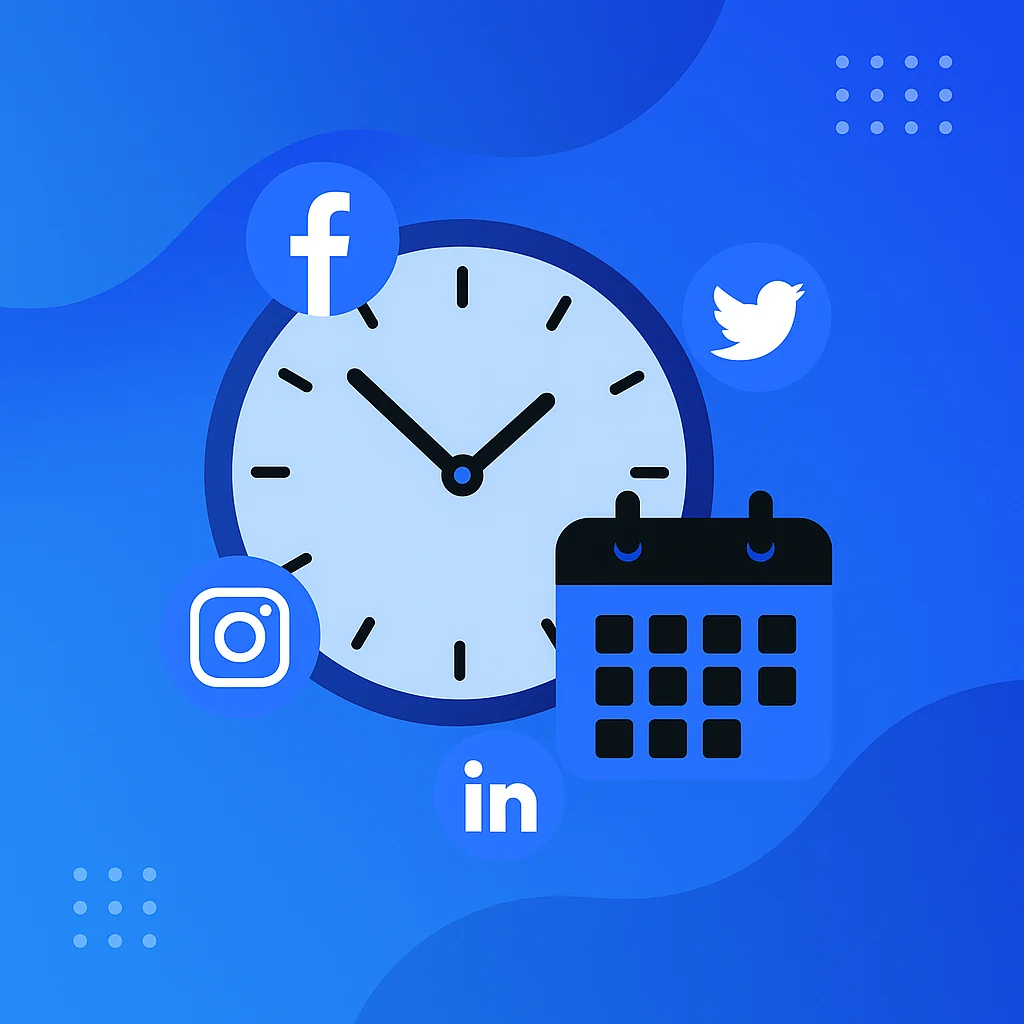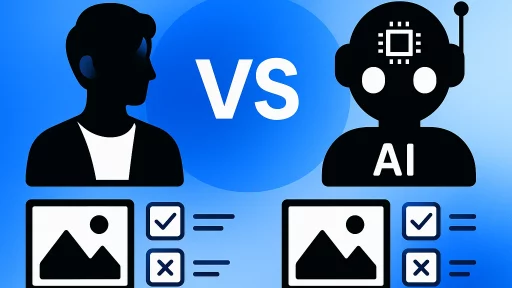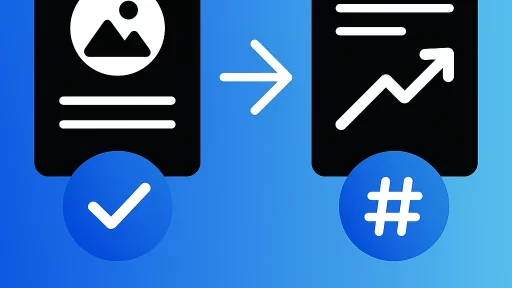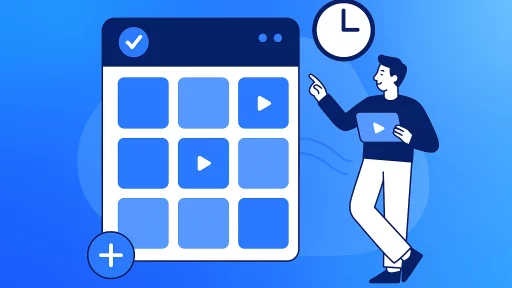Social media engagement often feels like a guessing game. You craft compelling content, hit publish, and hope for the best.
But timing matters more than most marketers realise. Posting when your audience is actively scrolling dramatically increases the likelihood of likes, comments, shares, and meaningful interactions.
The difference between posting at 3 a.m. and 9 a.m. can mean reaching 50 people versus 5,000. Understanding when your specific audience engages transforms your content performance.
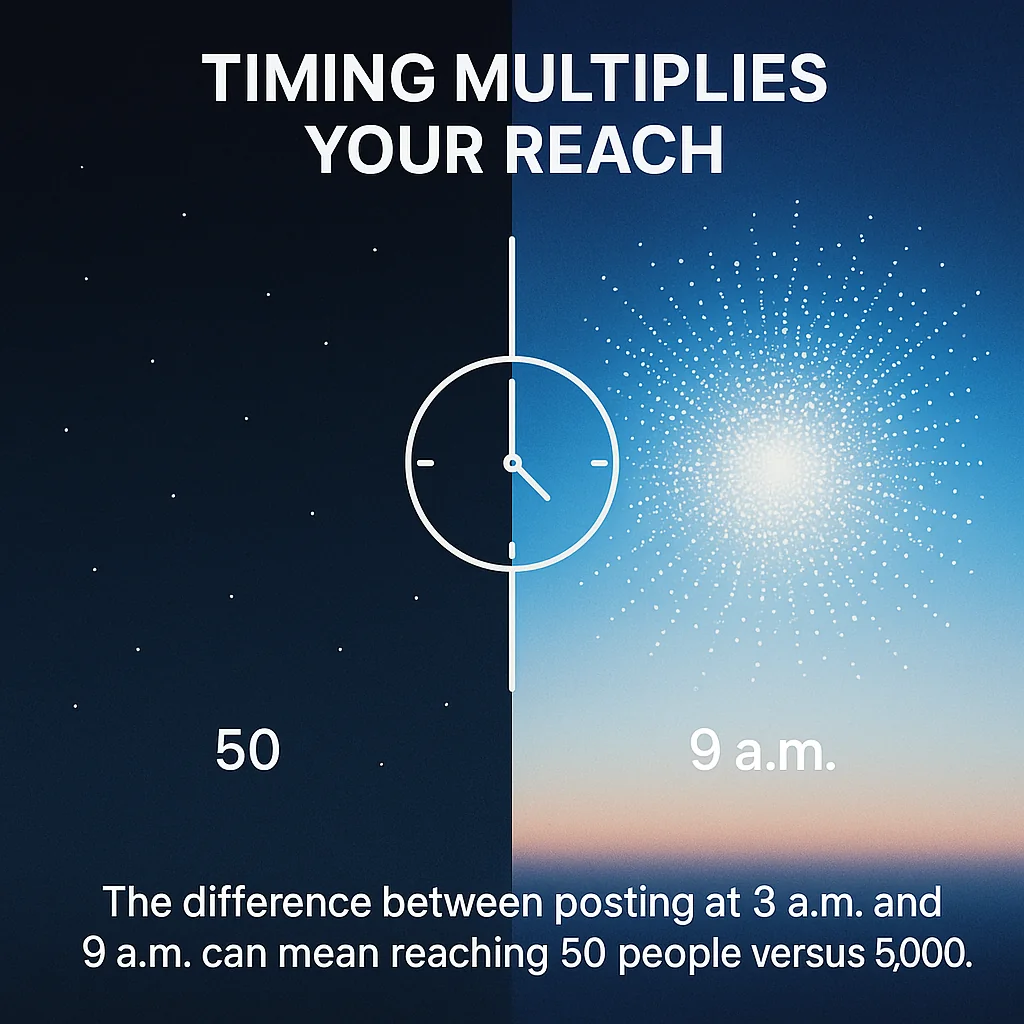
This guide examines platform-specific data to identify when engagement peaks across Facebook, Instagram, LinkedIn, TikTok, YouTube, and X (formerly Twitter). We’ll explore weekday versus weekend patterns, time zone considerations, and how to test these recommendations for your unique audience.
By the end, you’ll understand exactly when to schedule posts for maximum visibility and engagement on every major platform.
Understanding Social Media Timing Strategy
Social media algorithms prioritise recent, engaging content. When you publish during peak activity periods, more users see your posts immediately.
This initial engagement signals quality to platform algorithms. Higher early engagement leads to broader distribution in feeds and discovery sections.
The timing-engagement relationship works because active users scroll, click, and interact more frequently. Your content competes with fewer posts when most users aren’t online.
During peak hours, competition increases but so does potential reach. The key is finding windows when your specific audience is both active and receptive.
Platform Algorithms and Posting Times
Each platform uses different ranking factors. Facebook prioritises content from friends and family during active browsing sessions.
Instagram’s algorithm considers recency alongside predicted interest. TikTok’s “For You” page prioritises watch time and completion rates regardless of posting time.
LinkedIn favours professional content during work hours. YouTube recommends videos based on viewing history and session duration rather than strict timing.
Understanding these differences helps explain why optimal times vary across platforms. A Tuesday morning post works brilliantly on LinkedIn but may underperform on Instagram.
Audience Behaviour Patterns
Your audience’s daily routines determine when they check social media. Commuters scroll during morning travel and lunch breaks.
Office workers browse during mid-morning coffee breaks and afternoon lulls. Evening hours attract casual browsers relaxing after work.
Weekend patterns differ significantly. Saturday and Sunday engagement often peaks later in the morning when users wake without work commitments.
Business-to-business (B2B) audiences engage primarily during weekday work hours. Business-to-consumer (B2C) audiences spread engagement throughout evenings and weekends.
How Optimal Posting Times Are Determined
Researchers analyse millions of posts to identify engagement patterns. They measure likes, comments, shares, clicks, and video views across different publishing times.
Sample sizes typically include hundreds of thousands of accounts. Data spans multiple industries, audience sizes, and content types.
Statistical analysis identifies recurring peaks. If Tuesday at 10 a.m. consistently generates 20% more engagement than other times, that pattern becomes a recommendation.
Data Limitations and Considerations
General timing recommendations provide starting points, not absolute rules. Your specific audience may behave differently than aggregate data suggests.
Industry differences matter significantly. Healthcare audiences engage differently than entertainment followers. Geographic location affects time zone considerations.
Content type influences optimal timing too. Educational content may perform better during focused morning hours whilst entertainment content thrives during evening relaxation.
Seasonal variations, holidays, and cultural events shift engagement patterns temporarily. Back-to-school season, Christmas, and summer holidays all alter social media behaviour.
Testing Your Audience’s Preferences
Use platform analytics to track your performance across different posting times. Facebook Insights, Instagram Insights, and LinkedIn Analytics show when your followers are most active.
Schedule identical content types at various times throughout the week. Compare engagement rates to identify your audience’s peak activity windows.
Track metrics consistently over 4-6 weeks. Single-day fluctuations may mislead whilst longer patterns reveal genuine preferences.
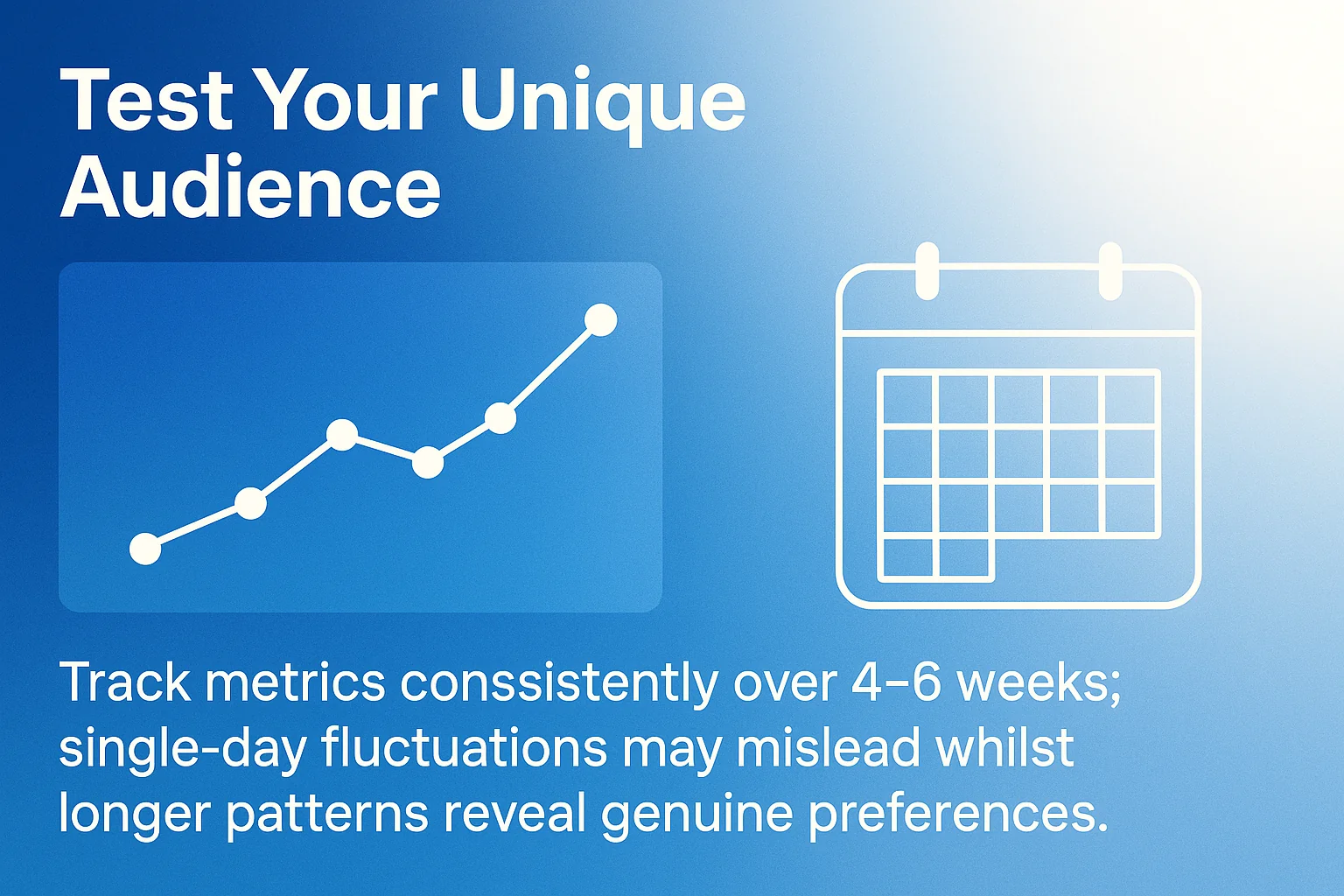
Document your findings in a simple spreadsheet. Note which days and times generate highest engagement for different content formats.
Best Times to Post on Facebook
Facebook engagement peaks during midweek mornings. Tuesday through Thursday from 9 a.m. to 10 a.m. consistently delivers strong results.
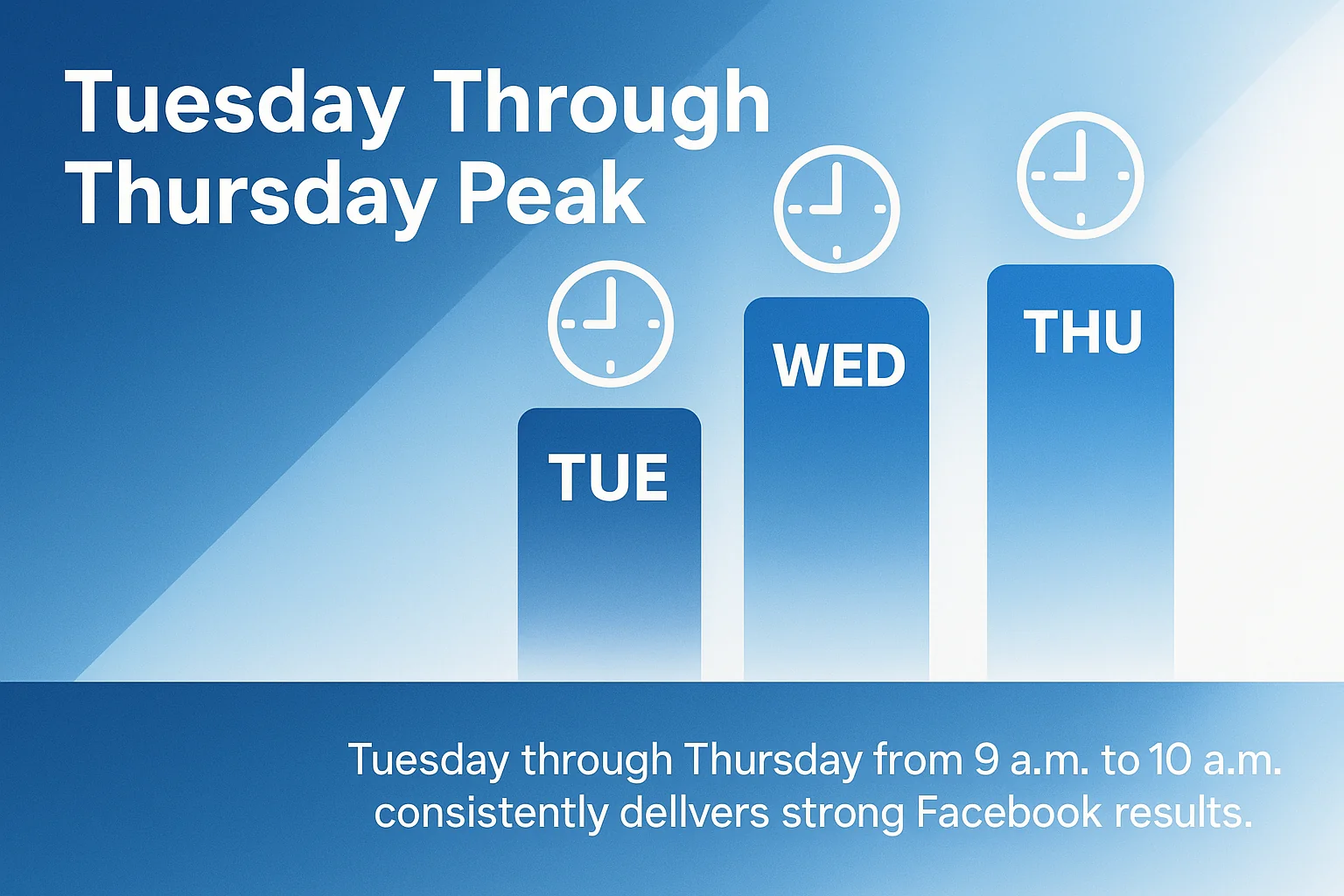
These morning hours catch users checking Facebook before diving into work tasks. The 9 a.m. to 10 a.m. window offers high visibility with manageable competition.
Tuesday and Thursday slightly outperform other weekdays. Monday morning competes with catching up on weekend emails and planning the week.
Friday afternoons see declining engagement as workers mentally shift toward weekend plans. Weekend posting typically underperforms weekdays for most business pages.
Facebook Engagement by Day
| Day | Optimal Time | Secondary Window |
|---|---|---|
| Monday | 9 a.m. – 10 a.m. | 1 p.m. – 2 p.m. |
| Tuesday | 9 a.m. – 10 a.m. | 12 p.m. – 1 p.m. |
| Wednesday | 9 a.m. – 10 a.m. | 1 p.m. – 2 p.m. |
| Thursday | 9 a.m. – 10 a.m. | 12 p.m. – 1 p.m. |
| Friday | 9 a.m. – 10 a.m. | 11 a.m. – 12 p.m. |
Weekday Versus Weekend Performance
Weekdays consistently outperform weekends for most platforms in terms of engagement. This pattern holds particularly true for Facebook business pages.

Weekend audiences tend toward personal connections rather than brand content. Users prioritise catching up with friends and family over following business updates.
However, entertainment and lifestyle brands may find weekend audiences more receptive. Test Saturday and Sunday posting if your content aligns with leisure activities.
If posting on weekends, aim for Saturday morning between 10 a.m. and 11 a.m. when users casually browse over coffee.
Time Zone Considerations for Facebook
Most scheduling tools allow posting in your audience’s local time zones. If your followers span multiple regions, schedule multiple posts.
Check Facebook Insights to see where your audience lives. If 60% are in one time zone, prioritise that region’s optimal hours.
Global brands might schedule three posts: one for European morning hours, one for North American mornings, and one for Asian audiences.
This approach maximises reach without overwhelming any single audience with duplicate content in their feeds.
Best Times to Post on Instagram
Instagram shows different engagement patterns than Facebook. Weekday lunch breaks from 11 a.m. to 2 p.m. generate strong engagement, alongside evening hours from 8 p.m. to 10 p.m.
Lunchtime scrolling provides a brief escape from work. Users quickly browse, like, and comment during these breaks.
Evening hours attract longer browsing sessions. Users relax on the sofa, engaging more deeply with content through comments and shares.
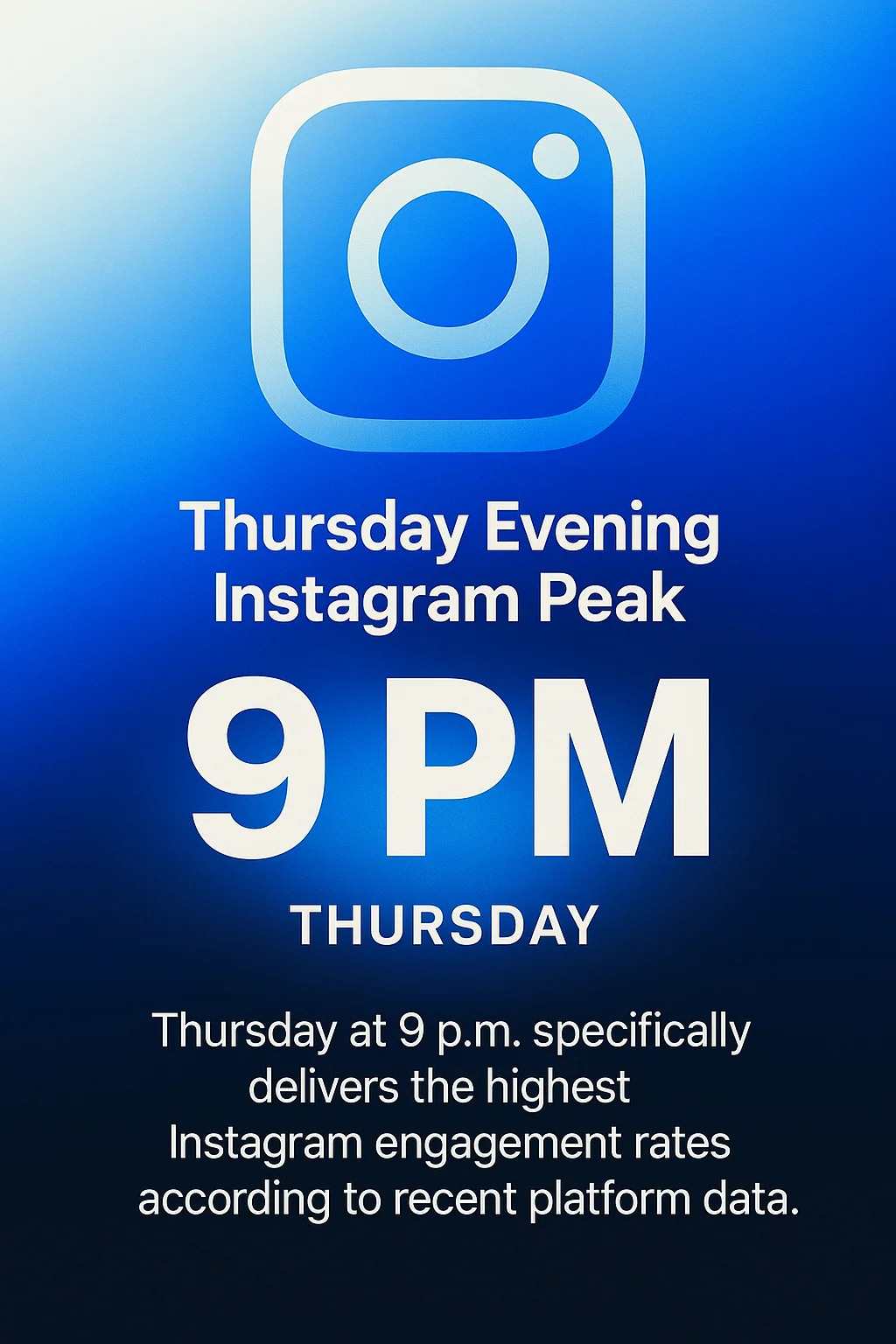
Instagram Stories Versus Feed Posts
Stories perform well throughout the day because they appear at the top of the app. Users check Stories habitually every time they open Instagram.
Feed posts benefit more from strategic timing. The algorithm determines feed ranking based on predicted interest and recency.
Post Stories during high-traffic periods: morning commutes (7 a.m. to 9 a.m.), lunch breaks (12 p.m. to 2 p.m.), and evening wind-down (7 p.m. to 10 p.m.).
Schedule feed posts during the recommended peak windows whilst using Stories to maintain presence throughout the day.
Reels and Video Content Timing
Instagram Reels can gain traction at any time through the Reels feed. However, posting during peak hours provides initial momentum.
Evening hours work particularly well for Reels. Users spend more time watching video content when relaxing rather than during quick daytime checks.
Weekday evenings from 7 p.m. to 10 p.m. and weekend mornings from 9 a.m. to 11 a.m. both perform well for video content.
The first hour after posting critically influences Reels performance. Strong early engagement signals quality to Instagram’s algorithm, leading to broader distribution.
Weekend Instagram Engagement
Instagram sees stronger weekend performance than Facebook. Saturday mornings around 9 a.m. to 11 a.m. generate solid engagement.
Users browse Instagram leisurely on weekends, often whilst having breakfast or enjoying morning coffee. This relaxed mindset encourages interaction.
Sunday engagement remains decent but slightly lower than Saturday. Many users prepare for the upcoming work week, reducing social media time.
Lifestyle, fashion, food, and travel content often performs exceptionally well during weekend hours when users seek inspiration.
Best Times to Post on LinkedIn
LinkedIn operates on a professional schedule. Weekday work hours dominate engagement, particularly Tuesday through Thursday.
Morning hours from 8 a.m. to 10 a.m. catch professionals checking LinkedIn over coffee. Mid-morning browsing often coincides with taking breaks from focused work.
Lunch hours from 12 p.m. to 1 p.m. provide another engagement peak. Professionals scroll whilst eating or taking midday mental breaks.
Tuesday, Wednesday, and Thursday mornings specifically deliver the strongest results for business content and professional insights.
B2B Content Strategy on LinkedIn
Business-to-business content requires professional mindset engagement. Posting when your audience is in “work mode” dramatically improves performance.
Early morning posts (7 a.m. to 8 a.m.) catch ambitious professionals starting their day. They’re mentally fresh and receptive to industry insights.
Avoid posting during typical meeting hours (10 a.m. to 11 a.m., 2 p.m. to 4 p.m.). Engagement drops when professionals are occupied.
Late afternoon posts (4 p.m. to 5 p.m.) catch end-of-day browsing as workers wind down and check for industry updates.
LinkedIn Analytics and Audience Insights
LinkedIn provides detailed analytics about follower demographics and activity patterns. Check your Company Page analytics to see when your specific audience is online.
The “Visitors” tab shows which days and times generate the most page views. Compare these patterns against your posting schedule.
If you’re posting at 2 p.m. but your audience peaks at 9 a.m., adjust your schedule accordingly.
Track engagement rates across different posting times for at least one month. Small sample sizes may show misleading patterns.
Weekend LinkedIn Performance
LinkedIn engagement drops significantly on weekends. Most professionals disconnect from work-related platforms during personal time.
Saturday and Sunday posts typically reach 30% to 50% fewer users than weekday posts with identical content.
However, thought leadership content and career advice sometimes perform acceptably on Sunday evenings. Professionals preparing for Monday may seek motivational or educational content.
If you must post on weekends, aim for Sunday evening between 5 p.m. and 7 p.m. when professionals mentally transition back to work mode.
Best Times to Post on TikTok
Thursday mornings catch users checking TikTok during commutes or morning routines. Friday afternoon peaks align with workers mentally checking out early for the weekend.
TikTok’s algorithm differs from other platforms. The “For You” page prioritises video completion rates and watch time over strict posting schedules.
Viral TikToks can gain traction days or weeks after posting. However, initial engagement during peak hours provides momentum.
TikTok’s Algorithm and Timing
TikTok tests new videos with small audience samples. If those initial viewers watch completely and engage, the algorithm expands distribution.
Posting during high-activity periods means your test audience includes more active users. Active users are more likely to watch, like, and share.
The first few hours after posting matter most. Strong early performance signals quality, leading to exponentially broader reach.
However, TikTok can resurface old content if it starts gaining traction. This differs from other platforms where old posts rarely gain new visibility.
Age Demographics and Timing
TikTok’s user base skews younger than Facebook or LinkedIn. Teenagers and young adults dominate the platform.
School-age users check TikTok before school (6 a.m. to 8 a.m.), during lunch breaks (12 p.m. to 1 p.m.), and heavily after school (3 p.m. to 6 p.m.).
Young professionals engage during lunch hours and evening relaxation periods similar to other platforms.
Weekend engagement remains strong throughout the day. Saturday and Sunday between 10 a.m. and 4 p.m. both generate solid performance.
Content Type Considerations
Educational content performs well during morning hours when users seek information or motivation to start their day.
Entertainment content thrives during evening hours when users scroll for leisure. Comedy, dance, and lifestyle content benefit from relaxed evening mindsets.
Trending challenges and audio tracks can override typical timing patterns. Jumping on trends early matters more than perfect posting times.
Test different times for different content categories. Your educational videos might peak at 8 a.m. whilst your entertainment content excels at 8 p.m.
Best Times to Post on YouTube
YouTube operates differently than feed-based platforms. Videos gain views over extended periods rather than requiring immediate engagement.
However, initial posting times still matter. Early engagement influences YouTube’s recommendation algorithm, which drives the majority of views.
Weekday afternoons from 2 p.m. to 4 p.m. and weekday evenings from 6 p.m. to 9 p.m. typically generate strong initial viewing sessions.
Weekend mornings from 9 a.m. to 11 a.m. work well for longer-form content when viewers have time to watch complete videos.
YouTube Watch Time and Algorithm
YouTube prioritises watch time over engagement metrics like likes or comments. Videos that keep viewers watching perform better.
Posting when users have time for longer viewing sessions helps accumulate watch hours quickly. Evening hours work well for 10-30 minute videos.
Shorter videos (under 5 minutes) can succeed during lunch breaks or morning commutes when viewers have limited time.
The algorithm learns viewer preferences over time. Consistent posting schedules train your audience to expect and watch new uploads.
Subscriber Notifications and Timing
Subscribers with notifications enabled see your uploads immediately. These early viewers significantly influence algorithmic distribution.
Post when your most engaged subscribers are likely online. Check YouTube Analytics to see when your subscribers are most active.
Early views, likes, and comments signal quality to YouTube. This initial momentum leads to recommendations on the homepage and suggested videos.
Posting consistently at the same time trains subscribers to check for new content during those hours, improving early engagement.
Content Category Timing Strategies
Tutorial and educational videos perform well during morning and lunch hours. Users seeking solutions search YouTube when encountering problems.
Entertainment content thrives during evening leisure hours. Comedy, commentary, and lifestyle videos benefit from relaxed viewing mindsets.
Gaming content often peaks during late evening and weekend hours when gamers have extended playing time.
News and current events content should publish immediately when relevant, regardless of optimal timing. Timeliness matters more than scheduling.
Best Times to Post on X (Twitter)
X (formerly Twitter) moves faster than other platforms. Tweets have shorter lifespans, typically generating most engagement within 30 minutes of posting.
Weekday mornings from 8 a.m. to 10 a.m. catch users checking X with their morning coffee. Mid-morning engagement remains solid.
Lunch hours from 12 p.m. to 1 p.m. provide another peak. Quick-consumption content suits brief lunch break browsing.
Early evening from 5 p.m. to 6 p.m. catches commuters and workers wrapping up their day.
Tweet Frequency and Timing
Unlike other platforms where posting too frequently overwhelms followers, X encourages multiple daily posts. Active accounts often tweet 5-15 times daily.
Spread tweets throughout peak hours rather than clustering them. One tweet every 2-3 hours maintains presence without spamming followers.
Time-sensitive content should post immediately regardless of scheduling. News, live event commentary, and trending topic participation require real-time posting.
Scheduled promotional content can follow optimal timing guidelines whilst maintaining flexibility for timely engagement.
Engagement Tactics on X
Replies and conversations drive X engagement more than standalone tweets. Respond to followers during high-activity periods when conversations flourish.
Morning hours generate more thoughtful discussions. Users engage in longer exchanges before their workday becomes hectic.
Evening hours see more casual banter and entertainment-focused engagement. Humour and lighter content perform well during evening scrolling.
Weekend X engagement remains decent for news, sports, and entertainment topics. Professional and business content typically underperforms on Saturdays and Sundays.
X Analytics and Performance Tracking
X Analytics shows impressions, engagements, and engagement rates for individual tweets. Compare performance across different posting times.
Track which hours generate highest engagement rates (not just impressions). A tweet with 1,000 impressions and 100 engagements outperforms one with 5,000 impressions and 50 engagements.
Notice patterns across tweet types. Your promotional content might peak at different times than your educational or conversational tweets.
Adjust your strategy based on at least 2-3 weeks of data. Individual tweet performance varies too much for single-day conclusions.
Comparing Weekday and Weekend Engagement
Most social media platforms see stronger engagement during weekdays. Professional mindsets and routine browsing habits drive consistent weekday activity.
Tuesday through Thursday represent the engagement sweet spot. Monday competes with catching up after the weekend whilst Friday sees declining attention.
Weekend engagement varies significantly by platform and content type. Business content typically struggles whilst entertainment and lifestyle content may thrive.
Platform-Specific Weekend Performance
| Platform | Weekend Performance | Best Weekend Times |
|---|---|---|
| Moderate decline | Saturday 10 a.m. – 11 a.m. | |
| Strong performance | Saturday 9 a.m. – 11 a.m. | |
| Significant decline | Sunday 5 p.m. – 7 p.m. | |
| TikTok | Consistent engagement | Saturday 10 a.m. – 4 p.m. |
| YouTube | Strong for long content | Saturday/Sunday 9 a.m. – 11 a.m. |
| X (Twitter) | Moderate for trending topics | Saturday/Sunday 8 a.m. – 10 a.m. |
Adjusting Strategy for Your Industry
B2B companies should focus heavily on weekday posting. Decision-makers rarely engage with professional content during personal time.
B2C brands in entertainment, food, travel, and lifestyle often find weekend audiences more receptive. Users seek inspiration and entertainment during leisure time.
Retail brands may see increased weekend engagement when shoppers actively browse for purchases. Saturday morning through early afternoon works well.
Test your specific audience rather than assuming industry norms apply. Your followers may behave differently than broader category trends.
Time Zone Considerations and Global Audiences
Global audiences require strategic time zone management. A single posting time can’t optimise for London, New York, and Sydney simultaneously.
Identify where your audience concentrates. If 70% of followers live in one region, prioritise that time zone.
For distributed audiences, consider multiple posts. Schedule content to hit morning hours in each major geographic region.
Using Scheduling Tools for Time Zones
Buffer, Hootsuite, and Later all allow timezone-specific scheduling. You can post identical content at optimal local times across regions.
This approach maximises reach without requiring you to wake at inconvenient hours. Set schedules once, and the tool handles timing automatically.
Some platforms like Facebook and Instagram allow targeting posts to specific geographic regions. Combine geographic targeting with optimal timing for each region.
Monitor which geographic segments generate strongest engagement. Double down on regions showing high performance whilst testing approaches for lower-performing areas.
Balancing Frequency Across Time Zones
Posting for multiple time zones increases total post frequency. Ensure this doesn’t overwhelm followers who see multiple posts.
Most platforms show posts algorithmically rather than chronologically. Users won’t necessarily see every post you publish.
However, avoid posting identical content more than twice within 24 hours on the same platform. This redundancy annoys engaged followers.
Vary content slightly for different regions. Different geographic audiences may prefer different angles or examples relevant to their local context.
Social Media Scheduling Tools and Automation
Scheduling tools eliminate the need to manually post during optimal times. You can prepare content in batches and schedule weeks in advance.
Buffer offers clean scheduling interfaces with optimal time suggestions based on your past performance.
Hootsuite provides comprehensive analytics alongside scheduling capabilities for multiple platforms.
Later specialises in visual content planning, particularly useful for Instagram and Pinterest scheduling.
Automation Without Losing Authenticity
Scheduled content should feel genuine, not robotic. Write naturally and include timely references when scheduling.
Leave room for spontaneous posting. Scheduling shouldn’t prevent you from engaging with trending topics or time-sensitive conversations.
Monitor scheduled posts after they publish. Respond to comments and engagement promptly to maintain authentic connections.
Mix scheduled content with real-time interaction. Users appreciate both consistent content and genuine, spontaneous engagement.
Analytics and Performance Tracking
Most scheduling tools include analytics showing which posting times generate best results for your specific audience.
Track engagement rates rather than just engagement counts. A post with 50 engagements from 500 impressions (10% rate) outperforms one with 100 engagements from 5,000 impressions (2% rate).
Compare similar content types posted at different times. This isolates timing effects from content quality differences.
Review analytics monthly to identify patterns. Adjust your posting schedule based on what your data shows rather than general recommendations.
Building a Content Calendar
A structured content calendar helps maintain consistency. Plan content themes weekly or monthly whilst identifying optimal posting slots.
Include optimal times directly in your calendar. When planning Tuesday content, note “Tuesday 9 a.m.” rather than vague scheduling.
Balance different content types throughout the week. Mix promotional posts with educational content and engagement-focused posts.
Use content calendar templates to streamline planning. Templates ensure you don’t miss key posting opportunities or overload specific days.
Testing and Optimising Your Posting Schedule
General recommendations provide starting points. Your specific audience requires personalised testing to identify true optimal times.
Start with industry recommendations, then systematically test variations. Post similar content at different times and compare results.
Run tests for at least 4-6 weeks. Short-term fluctuations don’t indicate genuine patterns.
Creating a Testing Framework
Document your current posting schedule and baseline engagement rates. You need comparison points to measure improvement.
Change one variable at a time. Test different posting times whilst keeping content quality and format consistent.
Create a simple spreadsheet tracking posting time, engagement metrics, and notes about content type. Look for patterns across multiple posts.
Compare engagement rates (not just total engagement). Account for audience growth by calculating percentages relative to follower count.
Interpreting Test Results
Look for consistent patterns across multiple posts. One high-performing Tuesday doesn’t prove Tuesday is optimal.
Consider external factors that might skew results. Holidays, major news events, and seasonal changes temporarily alter engagement patterns.
Compare performance within content categories. Your video content might peak at different times than your text posts.
Be willing to contradict general recommendations if your data shows different patterns. Your audience’s unique behaviour matters more than aggregate statistics.
Iterating Your Strategy
Social media behaviour evolves. What worked six months ago may not work today. Review your posting strategy quarterly.
Seasonal variations affect engagement. Summer holidays, Christmas, and back-to-school periods all shift browsing habits temporarily.
Platform algorithm updates can change engagement patterns. Stay informed about major platform changes that might affect timing strategies.
Continue testing even after finding successful patterns. Audience growth, demographic shifts, and changing content mix all warrant retesting.
Advanced Considerations for Maximum Engagement
Beyond basic timing, several factors influence engagement. Combining optimal posting times with these considerations amplifies results.
Content Format and Timing Synergy
Different content formats perform better at different times. Video content often thrives during evening leisure hours.
Quick, digestible content (images, short text) works well during brief browsing windows like morning commutes or lunch breaks.
Long-form content and detailed guides perform better when users have focused attention, typically morning work hours.
Match your content format to the browsing mindset at different times. Entertainment content for evenings, educational content for mornings.
Consistency Builds Audience Expectations
Regular posting schedules train your audience to expect content. Followers who know you post Tuesday and Thursday mornings check specifically during those times.
Consistency matters more than posting at the theoretically optimal hour. Regular posting at 10 a.m. outperforms irregular posting at “perfect” times.
Create a sustainable schedule you can maintain long-term. Posting daily during an initial burst, then dropping to weekly posting confuses audiences.
Block content creation time separately from posting. Batching content creation and using scheduling tools maintains consistency without daily manual posting.
Engagement Tactics Beyond Timing
Posting at optimal times gets your content seen. Converting views into engagement requires compelling content.
Ask questions that invite responses. Posts ending with “What’s your experience?” or “Which approach works for you?” generate more comments.
Use strong visuals that stop scrollers. Eye-catching images or video thumbnails increase click-through rates regardless of posting time.
Respond promptly to early comments. Active conversations signal engagement to algorithms, increasing your post’s distribution.
Quick Answers to Common Questions
What is the 4-1-1 rule on social media?
The 4-1-1 rule guides content sharing: for every six posts, share four pieces of curated content from others, one original post, and one promotional post. This balance maintains audience engagement without overwhelming followers with self-promotion.
Taking Action on Optimal Posting Times
Understanding optimal posting times transforms social media performance. The data consistently shows midweek mornings work best across most platforms.
Start by implementing platform-specific recommendations. Post on Facebook Tuesday through Thursday from 9 a.m. to 10 a.m. Schedule Instagram content for weekday lunch breaks and Thursday evenings.
Use LinkedIn during work hours, particularly Tuesday through Thursday mornings. Time TikTok posts for Thursday and Friday peaks. Schedule X posts during morning coffee hours and lunch breaks.
But remember these are starting points. Your specific audience may behave differently than aggregate data suggests.
Track your results consistently. Use platform analytics and scheduling tools to identify patterns in your engagement data.
Test systematically over 4-6 weeks. Compare similar content posted at different times. Look for consistent patterns rather than single-post anomalies.
Build a sustainable content plan around your findings. Consistency matters more than chasing the theoretically perfect posting time.
Automate scheduling to maintain consistency without requiring manual posting during optimal hours. This frees your time for content creation and authentic engagement.
Combine smart timing with quality content and genuine engagement. Posting at 9 a.m. Tuesday won’t save poor content, but it will amplify good content’s reach.
Review and adjust quarterly. Social media behaviour evolves. What works today may need refinement in three months.
The goal isn’t perfection. It’s consistent improvement. Each small optimisation compounds over time, steadily growing your reach and engagement.
